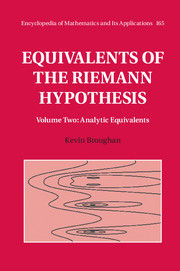Book contents
- Frontmatter
- Dedication
- Epigraph
- Contents
- Miscellaneous Frontmatter
- List of Illustrations
- List of Tables
- Preface for Volume Two
- List of Acknowledgements
- 1 Introduction
- 2 Series Equivalents
- 3 Banach and Hilbert Space Methods
- 4 The Riemann Xi Function
- 5 The De Bruijn–Newman Constant
- 6 Orthogonal Polynomials
- 7 Cyclotomic Polynomials
- 8 Integral Equations
- 9 Weil's Explicit Formula, Inequality and Conjectures
- 10 Discrete Measures
- 11 Hermitian Forms
- 12 Dirichlet L-Functions
- 13 Smooth Numbers
- 14 Epilogue
- Appendix A Convergence of Series
- Appendix B Complex Function Theory
- Appendix C The Riemann–Stieltjes Integral
- Appendix D The Lebesgue Integral on R
- Appendix E The Fourier Transform
- Appendix F The Laplace Transform
- Appendix G The Mellin Transform
- Appendix H The Gamma Function
- Appendix I The Riemann Zeta Function
- Appendix J Banach and Hilbert Spaces
- Appendix K Miscellaneous Background Results
- Appendix L GRHpack Mini-Manual
- References
- Index
Preface for Volume Two
Published online by Cambridge University Press: 27 October 2017
- Frontmatter
- Dedication
- Epigraph
- Contents
- Miscellaneous Frontmatter
- List of Illustrations
- List of Tables
- Preface for Volume Two
- List of Acknowledgements
- 1 Introduction
- 2 Series Equivalents
- 3 Banach and Hilbert Space Methods
- 4 The Riemann Xi Function
- 5 The De Bruijn–Newman Constant
- 6 Orthogonal Polynomials
- 7 Cyclotomic Polynomials
- 8 Integral Equations
- 9 Weil's Explicit Formula, Inequality and Conjectures
- 10 Discrete Measures
- 11 Hermitian Forms
- 12 Dirichlet L-Functions
- 13 Smooth Numbers
- 14 Epilogue
- Appendix A Convergence of Series
- Appendix B Complex Function Theory
- Appendix C The Riemann–Stieltjes Integral
- Appendix D The Lebesgue Integral on R
- Appendix E The Fourier Transform
- Appendix F The Laplace Transform
- Appendix G The Mellin Transform
- Appendix H The Gamma Function
- Appendix I The Riemann Zeta Function
- Appendix J Banach and Hilbert Spaces
- Appendix K Miscellaneous Background Results
- Appendix L GRHpack Mini-Manual
- References
- Index
Summary
Why have these two volumes on equivalences to the Riemann hypothesis been written? Many would say that the Riemann hypothesis (RH) is the most noteworthy problem in all of mathematics. This is not only because of its relationship to the distribution of prime numbers, the fundamental building blocks of arithmetic, but also because there exist a host of related conjectures that will be resolved if RH is proved to be true and which will be proved to be false if the converse is demonstrated. These are the RH equivalences. The lists of equivalent conjectures have continued to grow ever since the hypothesis was first enunciated, over 150 years ago.
The many attacks on RH that have been reported, the numerous failed attempts, and the efforts of the many whose work has remained obscure, have underlined the problem's singular nature.
The aim of these volumes is to give graduate students and number theory researchers easy access to these methods and results in order that they might build on them. To this end, complete proofs have been included wherever possible, so readers might judge for themselves their depth and crucial steps. In a few places the more philosophical thoughts of experts have been reported. These for the most part have been paraphrased or quoted from the books of du Sautoy [215] or Sabbagh [210].
The two volumes are distinct, with a small amount of overlap. The first, Volume One [39], has an arithmetic orientation, with some analytic methods, especially those relying on themanipulation of inequalities. The equivalences found there are those of Caveney–Nicolas–Sondow, Franel–Landau, Hilbert– Pólya, Lagarias, Littlewood, Landau, Nicolas, Nazardonyavi–Yakubovich, Ramanujan–Robin, Redheffer, Shapiro, Shoenfeld, Spira and Shapiro. In addition, Volume One has criteria based on the divisibility graph, Dirichlet eta function and the symmetric group. There is a supporting MathematicaTM package, RHpack.
Volume Two, this book, contains equivalences with a strong analytic orientation. To support these, there is an extensive set of appendices containing fully developed proofs of most results.
- Type
- Chapter
- Information
- Equivalents of the Riemann Hypothesis , pp. xvii - xixPublisher: Cambridge University PressPrint publication year: 2017

